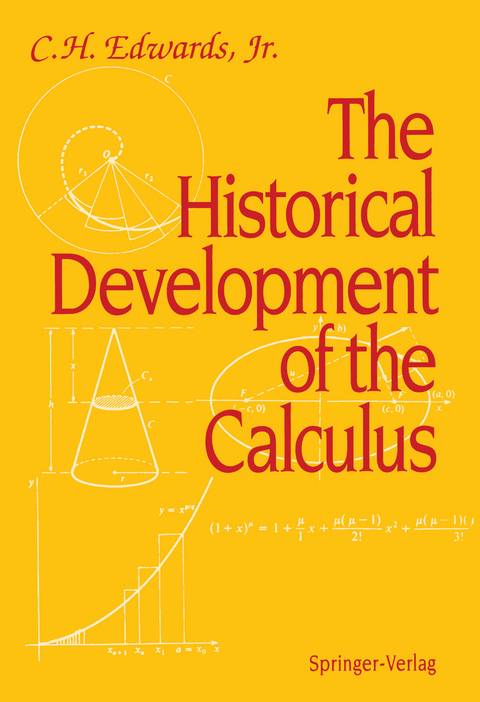The Historical Development of the Calculus
Springer-Verlag New York Inc.
978-0-387-94313-8 (ISBN)
1 Area, Number, and Limit Concepts in Antiquity.- Babylonian and Egyptian Geometry.- Early Greek Geometry.- Incommensurable Magnitudes and Geometric Algebra.- Eudoxus and Geometric Proportions.- Area and the Method of Exhaustion.- Volumes of Cones and Pyramids.- Volumes of Spheres.- References.- 2 Archimedes.- The Measurement of a Circle.- The Quadrature of the Parabola.- The Area of an Ellipse.- The Volume and Surface Area of a Sphere.- The Method of Compression.- The Archimedean Spiral.- Solids of Revolution.- The Method of Discovery.- Archimedes and Calculus?.- References.- 3 Twilight, Darkness, and Dawn.- The Decline of Greek Mathematics.- Mathematics in the Dark Ages.- The Arab Connection.- Medieval Speculations on Motion and Variability.- Medieval Infinite Series Summations.- The Analytic Art of Viète.- The Analytic Geometry of Descartes and Fermat.- References.- 4 Early Indivisibles and Infinitesimal Techniques.- Johann Kepler (1571–1630).- Cavalieri’s Indivisibles.- Arithmetical Quadratures.- The Integration of Fractional Powers.- The First Rectification of a Curve.- Summary.- References.- 5 Early Tangent Constructions.- Fermat’s Pseudo-equality Methods.- Descartes’ Circle Method.- The Rules of Hudde and Sluse.- Infinitesimal Tangent Methods.- Composition of Instantaneous Motions.- The Relationship Between Quadratures and Tangents.- References.- 6 Napier’s Wonderful Logarithms.- John Napier (1550–1617).- The Original Motivation.- Napier’s Curious Definition.- Arithmetic and Geometric Progressions.- The Introduction of Common Logarithms.- Logarithms and Hyperbolic Areas.- Newton’s Logarithmic Computations.- Mercator’s Series for the Logarithm.- References.- 7 The Arithmetic of the Infinite.- Wallis’ Interpolation Scheme and Infinite Product.-Quadrature of the Cissoid.- The Discovery of the Binomial Series.- References.- 8 The Calculus According to Newton.- The Discovery of the Calculus.- Isaac Newton (1642–1727).- The Introduction of Fluxions.- The Fundamental Theorem of Calculus.- The Chain Rule and Integration by Substitution.- Applications of Infinite Series.- Newton’s Method.- The Reversion of Series.- Discovery of the Sine and Cosine Series.- Methods of Series and Fluxions.- Applications of Integration by Substitution.- Newton’s Integral Tables.- Arclength Computations.- The Newton-Leibniz Correspondence.- The Calculus and the Principia Mathematica.- Newton’s Final Work on the Calculus.- References.- 9 The Calculus According to Leibniz.- Gottfried Wilhelm Leibniz (1646–1716).- The Beginning—Sums and Differences.- The Characteristic Triangle.- Transmutation and the Arithmetical Quadrature of the Circle.- The Invention of the Analytical Calculus.- The First Publication of the Calculus.- Higher-Order Differentials.- The Meaning of Leibniz’ Infinitesimals.- Leibniz and Newton.- References.- 10 The Age of Euler.- Leonhard Euler (1707–1783).- The Concept of a Function.- Euler’s Exponential and Logarithmic Functions.- Euler’s Trigonometric Functions and Expansions.- Differentials of Elementary Functions à la Euler.- Interpolation and Numerical Integration.- Taylor’s Series.- Fundamental Concepts in the Eighteenth Century.- References.- 11 The Calculus According to Cauchy, Riemann, and Weierstrass.- Functions and Continuity at the Turn of the Century.- Fourier and Discontinuity.- Bolzano, Cauchy, and Continuity.- Cauchy’s Differential Calculus.- The Cauchy Integral.- The Riemann Integral and Its Reformulations.- The Arithmetization of Analysis.- References.- 12 Postscript: TheTwentieth Century.- The Lebesgue Integral and the Fundamental Theorem of Calculus.- Non-standard Analysis—The Vindication of Euler?.- References.
| Reihe/Serie | Springer Study Edition |
|---|---|
| Zusatzinfo | XII, 368 p. |
| Verlagsort | New York, NY |
| Sprache | englisch |
| Maße | 155 x 235 mm |
| Themenwelt | Mathematik / Informatik ► Mathematik ► Analysis |
| Mathematik / Informatik ► Mathematik ► Geschichte der Mathematik | |
| ISBN-10 | 0-387-94313-7 / 0387943137 |
| ISBN-13 | 978-0-387-94313-8 / 9780387943138 |
| Zustand | Neuware |
| Haben Sie eine Frage zum Produkt? |
aus dem Bereich




